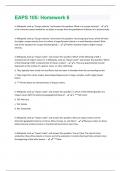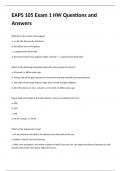Eaps 105 - Study guides, Class notes & Summaries
Looking for the best study guides, study notes and summaries about Eaps 105? On this page you'll find 56 study documents about Eaps 105.
Page 3 out of 56 results
Sort by

-
EAPS 105 Exam 2 Questions & Answers 2024
- Exam (elaborations) • 5 pages • 2024
- Available in package deal
-
- $7.99
- + learn more
EAPS 105 Exam 2 Questions & Answers 2024 Earth's interior temperatures - ANSWER-Inner core (Solid 5000 C), Outer core (liquid C), Mantle (Solid 3000 C) What are the consequences of a planet/moon being hot inside? - ANSWER-Differentiation, volcanism, plate tectonics, and magnetic fields What is the relationship between heat and the motion in atom? - ANSWER-Heat is a frequency of vibrations in atoms Primordial heating - ANSWER-Accretion and core formation Why is Io hot inside? -...
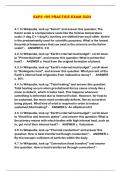
-
EAPS 105 PRACTICE EXAM 2024
- Exam (elaborations) • 4 pages • 2024
- Available in package deal
-
- $8.99
- + learn more
EAPS 105 PRACTICE EXAM 2024...
EAPS 105 Package Deal With Verified Study Solutions With Latest Updates

-
EAPS 105|71 Exam 1 Review Questions Well Anwered|2025
- Exam (elaborations) • 7 pages • 2024
- Available in package deal
-
- $7.99
- + learn more
Why the gas giants had to form within 3-10 million years from the birth of the Sun - ️️they had to attract hydrogen and helium gases before these were blown away by the solar wind Why the giant planets have faster spin rates than terrestrial planets - ️️because they are more massive Why the interiors of large asteroids and planets are very hot inside - ️️when they get big enough they heat up inside due to the heat of accretion and radioactive decay, causing the interior to melt Wh...
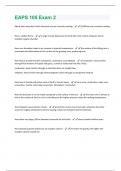
-
EAPS 105 Exam 2 (Questions & Answers) Rated 100% Correct!!
- Exam (elaborations) • 6 pages • 2024
- Available in package deal
-
- $7.99
- + learn more
About how many Near Earth Asteroids are we currently tracking - 20,000 we are currently tracking How a caldera forms - a large circular depression formed when the surface collapses into an emptied magma chamber How core formation leads to an increase in internal temperature - the motion of the falling iron is converted into deformation at the surface of the growing core, producing heat How heat is transferred with conduction, convection, and radiation - convection: heat transfer through fl...
EAPS 105 Exam 1 HW Questions and Answers

-
EAPS 105 EXAM 2 - 2024
- Exam (elaborations) • 3 pages • 2024
- Available in package deal
-
- $8.99
- + learn more
EAPS 105 EXAM 2 - 2024...
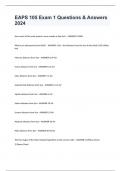
-
EAPS 105 Exam 1
- Exam (elaborations) • 7 pages • 2024
- Available in package deal
-
- $7.99
- + learn more
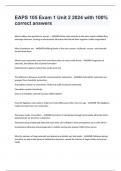
-
EAPS 105 Exam 1 Unit 2 2024 with 100% correct answers
- Exam (elaborations) • 4 pages • 2024
- Available in package deal
-
- $7.99
- + learn more
EAPS 105 Exam 1 Unit 2 2024 with 100% correct answers What enables dust particles to accrete. - ANSWER-When dust particles in the solar nebula collided they exchange electrons, causing an electrostatic attraction that bound them together (called coagulation) What chondrules are. - ANSWER-Building blocks of the solar system: all planets, moons, and asteroids formed from them Where most meteorites come from and where they are most easily found. - ANSWER-Fragments of asteroids, the lefto...
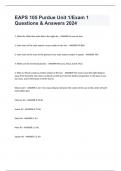
-
EAPS 105 Purdue Unit 1/Exam 1 Questions & Answers 2024
- Exam (elaborations) • 5 pages • 2024
- Available in package deal
-
- $7.99
- + learn more
EAPS 105 Purdue Unit 1/Exam 1 Questions & Answers 2024 1. What the Milky Way looks like in the night sky. - ANSWER-An arm of stars 2. How much of the solar system's mass resides in the Sun. - ANSWER-99.86% 3. How much of the mass of the planets in our solar system resides in Jupiter. - ANSWER-70% 4. Which are the terrestrial planets. - ANSWER-Mercury, Venus, Earth, Mars 5. Why our Moon creates a perfect eclipse of the Sun. - ANSWER-The moon is just the right distance away from ...

How much did you already spend on Stuvia? Imagine there are plenty more of you out there paying for study notes, but this time YOU are the seller. Ka-ching! Discover all about earning on Stuvia

